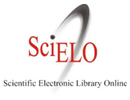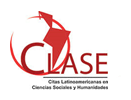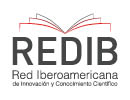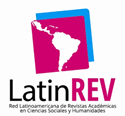Cognitive motivation of language and ways of thinking: a semiotic-cognitive analysis of the sociolect of the pandemic
DOI:
https://doi.org/10.21142/DES-1401-2022-0013Keywords:
Semiotics; cognitive linguistics; conceptual metaphor; conceptual metonymyAbstract
The research approaches from a semiotic-cognitive approach the analysis of the phraseological repertoire
that emerged in the period of the SARS-CoV-2 pandemic since the months of March and April in Peruvian society. The objective of this study is to propose a model of semiotic-cognitive analysis applied to any sociolect from a transversal perspective. The proposed model is based on cognitive linguistics and symbolic interactionism. Information was collected through the newspapers of the written press in Metropolitan Lima. The analysis allowed to establish that eight ways of thinking or conceptual procedures are evidenced in the cognitive processes of language. The research allows us to conclude that the sociolect generated by COVID-19 in Peruvian society, according to the cognitive perspective, represent symbolic units motivated through linguistic-cognitive processes of a metaphorical, metonymic and hyperbolic type.
Downloads
References
Alcócer, A. (2001). El sociolecto de los escolares limeños. Lexis, 25(1-2), pp. 15-31.
Brdar, M. y Brdar-Szabó, R. (2014). Where does metonymy begin? Some comments on Janda (2011). Cognitive Linguistics, 25(2), pp. 313-340. https://doi.org/10.1515/cog-2014-0013
Blumer, H. (1986). Symbolic interactionism. Perspective and method. University of California Press.
Boscá, J. E., Doménech, R. y Ferri, J. (2020). El impacto macroeconómico del Coronavirus. Documentos Macroeconomía FEDEA.
Carbonetti, A. (2009). Incidencia de la pandemia de gripe de 1918-1919 en la mortalidad de la ciudad de Córdoba. Ponencia presentada en las VII Jornadas Nacionales de Debate Interdisciplinario en Salud y Población, Instituto de Investigaciones Gino Germani, Buenos Aires.
Cebrelli, A. (2018). Diversidad sociolingüística en Argentina. Estado de la cuestión. Mediaciones, 14(20), pp. 70-118. http://dx.doi.org/10.26620/uniminuto.mediaciones.14.20.2018.70-118
Contreras, Ú. (2017). Breve análisis morfosintáctico de las expresiones de los periodistas policiales de Lima. Desde el Sur, 9(1), pp. 237-246.
Fauconnier, G. (1994). Mental spaces: Aspects of meaning construction in natural language. Cambridge University Press.
Gonzales, V. G., Morales, R. L. F., Gutiérrez, R. J. P., Tello, L. L. R. y Arango, N. C. (2019). Estudio léxico-semántico de la jerga en la expresión de los estudiantes de pregrado. Investigación Valdizana, 13(4), pp. 214-223.
Hendel, R. y Joosten, J. (2018). How to handle linguistic variation. En How old is the Hebrew Bible? (pp. 31- 46). Yale University Press.
Iskandar, D., Pujiono, M. y Samad, I. (2018). The profile of Acehnese variation: Sociolinguistic analysis. International Journal of Comparative Literature and Translation Studies, 6(3), pp. 12-19.
Kövecses, Z. y Radden, G. (1998). Metonymy: Developing a cognitive linguistic view. Cognitive Linguistics. 9(1), pp. 37-77. https://doi.org/10.1515/cogl.1998.9.1.37
Kövecses, Z. (2009). Metaphor, culture, and discourse: The pressure of coherence. En J. Zinken y A. Musolff (eds.), Metaphor in discourse (pp. 11-24). Benjamins.
Lakoff, G. y Johnson, M. (1980). Metaphors we live by. University of Chicago Press.
Lakoff, G. (1993). The contemporary theory of metaphor. En A. Ortony (ed.), Metaphor and thought. Vol. 2 (pp. 202-251). Cambridge University Press.
Loayza, E. (2011). Análisis pragmático del código oral del transporte público urbano («lenguaje combi») en Lima Metropolitana. Lengua y Sociedad, 11(1), pp. 91-100.
Loayza, E. (2013). Análisis pragmático de la jerga técnica de los estudiantes de la UNALM. Lengua y Sociedad, 13, pp. 155-167.
Loayza, E. (2020). La investigación cualitativa en Ciencias Humanas y Educación. Criterios para elaborar artículos científicos. Educare et Comunicare, 8(2), pp. 56-66. https://doi.org/10.35383/educare.v8i2.536
Lozano Ramírez, M. (2010). El sociolecto juvenil: un juego de probabilidades semánticas. Vigía del Idioma, 21, pp. 2-3. http://www.academiacolombianadelalengua.co/wp-content/uploads/2016/02/Boletin-21.pdf
Ocampo, J. (1968). Vocabulario de la jerga estudiantil de Bogotá. Thesaurus, 1(2), pp. 325-343.
Palacios, A. (2021). Comunicación lingüística, pensamiento y aprendizaje. En A. M, Palacios, M. A. Pedragosa y M. Querejeta (coords.), Conocimiento psicoeducativo en acción (pp. 44-57, cap. 5). Universidad Nacional de La Plata.
Peirsman, Y. y Geeraerts, D. (2006). Metonymy as a prototypical category. Cognitive Linguistics, 17(3), pp. 269-316. https://doi.org/10.1515/COG.2006.007
Pérez, M. (2006). Sociolecto y tecnolecto en los lenguajes de especialidad. En Análisis del discurso: lengua, cultura, valores. Actas del I Congreso Internacional (pp. 165-176). Arco Libros.
Radden, G. y Kövecses, Z. (1999). Towards a theory of metonymy. En K. U. Panther y G. Radden (eds.). Metonymy in language and thought (pp. 17-59). Benjamins.
Ramírez, N. (2009). Aspectos semánticos en la jerga estudiantil universitaria, Sede de Guanacaste. Káñina, 33(2).
Romanelli, S. (2013). El español y sus variedades. European Scientific Journal, 9(32), pp. 45-58.
Salazar Tantalean, K. y Sinchitullo Rosales, S. (2014). La categorización de algunos cuantificadores discursivos de medida en la lengua aimara. Desde el Sur, 6(2), pp. 35-43.
Sanou, R. (2017). La ruta de la sociolingüística variacionista. En A. Martínez, Y. Gonzalo y N. Busalino (coord.), Rutas de la lingüística en la Argentina II (pp. 60-81). Universidad Nacional de La Plata. http://www.libros.fahce.unlp.edu.ar/index.php/libros/catalog/book/86
Sperber, D. y Wilson, D. (1986). Relevance. Communication and cognition. Blackwell.
Sperber, D. y Wilson, D. (2007). Linguistic form and relevance. Lingua, 90, pp. 1-25.
Downloads
Published
Issue
Section
License

Esta obra está bajo una licencia http://creativecommons.org/licenses/by-nc-sa/4.0/



















